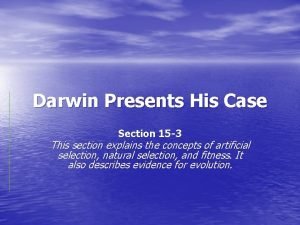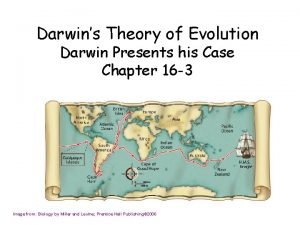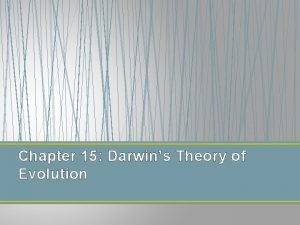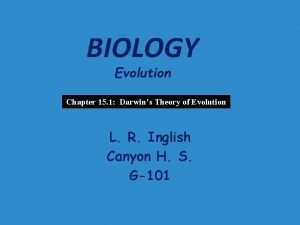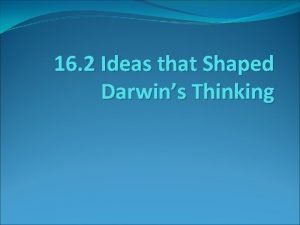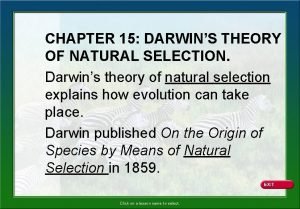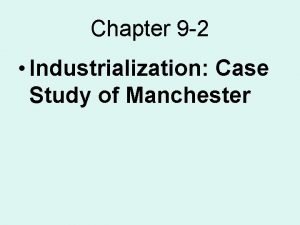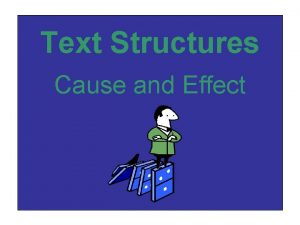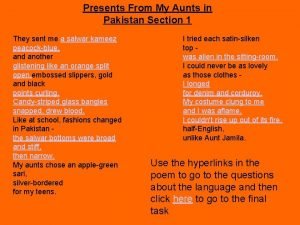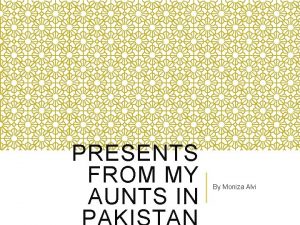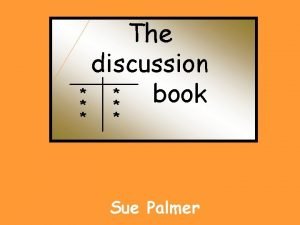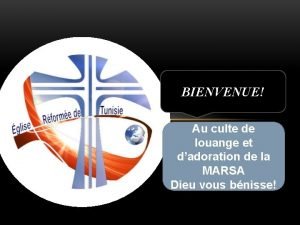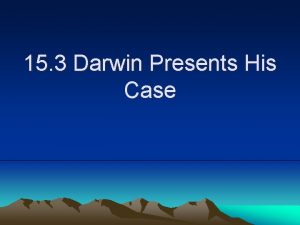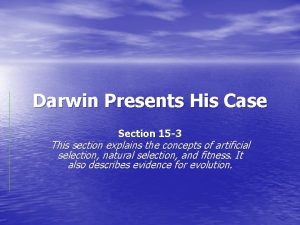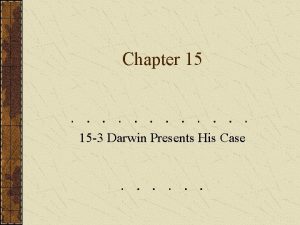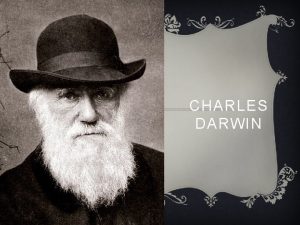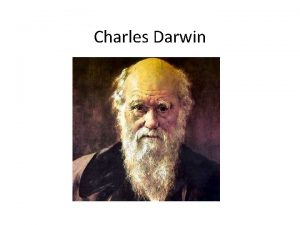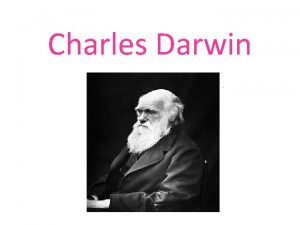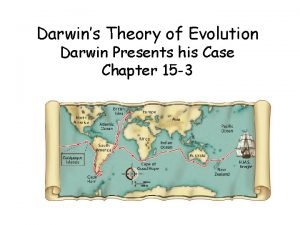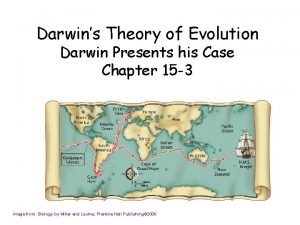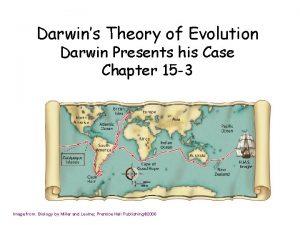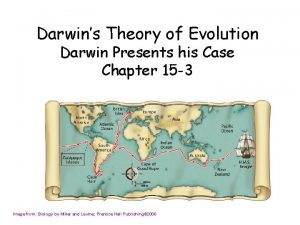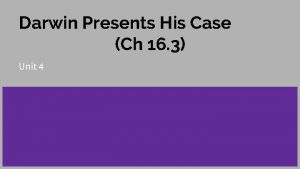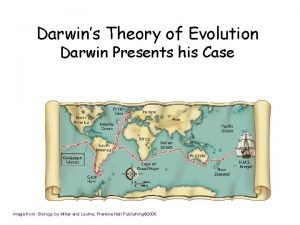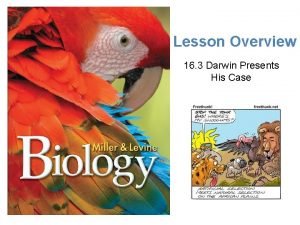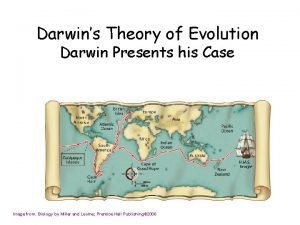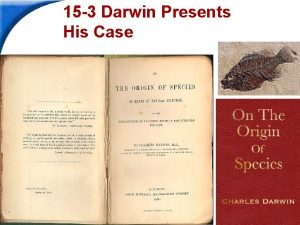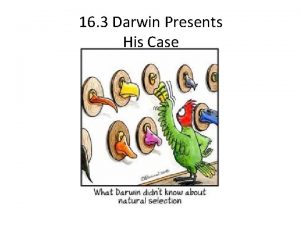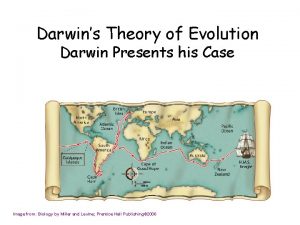Darwin Presents His Case CHAPTER 15 SECTION 3






















- Slides: 22

Darwin Presents His Case CHAPTER 15 SECTION 3 ESSENTIAL QUESTION: HOW IS NATURAL SELECTION RELATED TO FITNESS?

On The Origin of Species � 1858: after receiving a short essay from Wallace that summarized the thoughts on evolutionary change that were very similar to Darwin’s ideas…. . he went ahead and had his book published �book a success because it presented a mechanism to explain evolution

Artificial Selection �Darwin used example of wild mustard plant’s natural genetic variation & humans using artificial selection to yield wide variety of vegetables

Evolution by Natural Selection �Darwin next compared artificial selection with what is going on in nature: realized what Malthus predicted about the growth of human population applied to all organisms struggle for existence: limited resources give advantage for survival to those predators that are faster or those prey that are better camoflauged survival of the fittest: “fitness” a measure of how successful you are surviving & reproducing natural selection: results in changes in the inherited characteristics of a population; these changes increase a species’ fitness

Natural Selection �descent with modification: over time, natural selection produces organisms with different : structures niches habitats

Descent with Modification �implies all living organisms are related to one another �principle of common descent: all species both living and extinct were derived from common ancestors Tree of Life

Evidence of Evolution Fossil Record 2. Biogeography 3. Homologous Structures 4. Embryology 1.

Fossil Record �Darwin & scientists of his time knew: fossils were remains of ancient life sedimentary rock layers formed @ different times �Darwin proposed: countless species had come into being, lived for a time then vanished

Transitional Fossils

Biogeography �species living on different continents but with similar environments shared common features anatomy behaviors Darwin reasoned that animals exposed to similar forces of natural selection would evolve common characteristics


�How can two species that look very different from each other be more closely related than two other species that look similar to each other?

Continental Drift

Homologous Body Structure �structures that have different mature forms but develop from same embryonic tissues

Vestigial Organs �traces of organs that no longer serve a function these organs would have had a function in an ancestor

Vestigial Structures

Embryology �many vertebrates have embryonic stages showing close similarities

Summary of Darwin’s Theory Individuals of a population show genetic variation 2. Organisms produce more offspring than can survive & many that do survive do not reproduce 3. Because of #2 there is competition for limited resources 4. Each individual has different advantages & disadvantages in struggle for existence. Those best suited to their environment survive & reproduce most successfully; others less successful do not survive &/or do not reproduce as well: natural selection causes species to change over time 1.

Summary of Darwin’s Theory - 2 5. Species alive today are descended with modification from ancestral species: this process unites all organisms on Earth into a single Tree of Life

Darwin’s Theory Weaknesses Strengths �scientific advances in ecology, biology, DNA technology, physics, & geology have confirmed & expanded most of Darwin’s theory �Evolution called the “grand unifying theory of life” �How did that 1 st cell become a “living” organism? �Not always clear how new species form or why species become extinct

What Will You Do that Affects the Tree of Life?

 15-3 darwin presents his case
15-3 darwin presents his case 16 3 darwin presents his case answer key
16 3 darwin presents his case answer key Strengths and weaknesses of evolutionary theory page 386
Strengths and weaknesses of evolutionary theory page 386 Chapter 15 darwin's theory of evolution section 15-1
Chapter 15 darwin's theory of evolution section 15-1 Chapter 15 darwin's theory of evolution section review 15-1
Chapter 15 darwin's theory of evolution section review 15-1 Best worst and average case
Best worst and average case Section 15–2 ideas that shaped darwin’s thinking
Section 15–2 ideas that shaped darwin’s thinking 15-2 ideas that shaped darwins thinking
15-2 ideas that shaped darwins thinking Chapter 17 darwin's theory of evolution
Chapter 17 darwin's theory of evolution Chapter 15 darwin's theory of evolution
Chapter 15 darwin's theory of evolution Manchester2
Manchester2 Cause and effect text structure signal words
Cause and effect text structure signal words Presents from my aunts in pakistan
Presents from my aunts in pakistan Presents from my aunts in pakistan
Presents from my aunts in pakistan Business agility metrics
Business agility metrics Zids and zods
Zids and zods Sue palmer skeletons
Sue palmer skeletons Gurmit paid £21 for five presents
Gurmit paid £21 for five presents Prose writing that presents and explains ideas
Prose writing that presents and explains ideas Prose writing that presents and explains ideas
Prose writing that presents and explains ideas Gurmit paid £21 for five presents
Gurmit paid £21 for five presents Where does “snowflake girl” help to deliver presents
Where does “snowflake girl” help to deliver presents Quand je t'ouvre mon coeur je te vois seigneur
Quand je t'ouvre mon coeur je te vois seigneur
